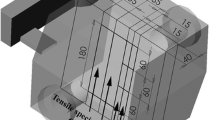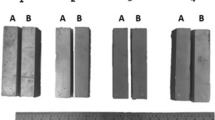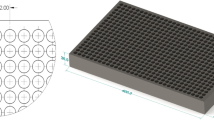Abstract
The objective of this paper is to review the factors influencing the formation of degenerated graphite layers on the surfaces of ductile iron castings for chemical resin-acid moulding and coremaking systems and how to reduce this defect. In the resin mould technique the sulphur in the P-toluol sulphonic acid (PTSA), usually used as a hardener, has been identified as one factor causing graphite degeneration at the metal mould interface. Less than 0.15% S in the mould (or even less than 0.07% S) can reduce the surface layer depth. Oxygen may also have an effect, especially for sulphur containing systems with turbulent flows in the mould, water-bearing no-bake binder systems, Mg-Silica reactions, or dross formation conditions. Despite the lower level of nitrogen in the iron melt after magnesium treatment (less than 90 ppm), nitrogen bearing resins have a profound effect on the frequency and severity of surface pinholes, but a limited influence on surface graphite degeneration. The specific characteristics and optimum conditions for the manufacture of heavy sectioned ductile iron windmill castings were reviewed. The paper concludes on the optimum iron chemistry, melting procedure, Mg-alloys and specific inoculants systems, as well as the practical solutions to limit graphite degeneration to ensure castings with the highest integrity.
Similar content being viewed by others
References
“Ductile Iron Techniques—Suggestions for Ductile Iron Production,” Montreal, Canada: Rio Tinto Iron & Titanium, Inc. (1971).
Karsay, S.I., “Ductile Iron Production (I) -The State of the Art,” Revised in part by QIT Technical Staff, QIT, Montreal, Canada (1992).
“Common Metallurgical Defects in Ductile Iron Chart,” Elkem Foundry Products Division, Oslo, Norway (2004).
Goodrich, G.M., “Cast Iron Microstructure Anomalies and Their Causes,” AFS Transactions, vol. 105, pp. 669–683 (1997).
Mullins, J.D., “Chunk Graphite Defects in Ductile Iron, Sorelmetal-Suggestions for Ductile Iron Production” (Data Sheet No. 93), Rio Tinto Iron & Titanium, Inc., Montreal, Canada (2006).
Pan, E.N. and Chen, C.Y., “Effects of Bi and Sb on Graphite Structure of Heavy-Section Ductile Cast Iron,” AFS Transactions, vol. 104, pp. 845–858 (1996).
Fallon, M.J., “Experiences in the Manufacture of Ductile Irons,” The Foundrymen, vol. 88, issue 9, pp. 308–318 (1995).
Baier, J. and Koppen, M., “Manual of Casting Defects. Incidence and Avoidance of Defects Attributable to Moulding Sands,” Marl, Germany: IKO-Erbsloh, pp. 32–35 (1994).
Golovan, N.A., Dudni, K.J.A., Dubrov, V.V., “Formation of Flake Graphite Near the Surface of Nodular Cast Iron Casting,” Russian Casting Production Journal, issue 7, pp. 35–36 (1977).
Watmough, T. and Malatesta, M.J., “Strengthening of Ductile Iron for Crankshaft Applications,” AFS Transactions, vol. 92, pp. 83–99 (1984).
Yamamura, H., Sekiguchi, M., Inoue, K., “Influence of Defects on the Fatigue Life of Ductile Cast Iron with As-Cast Surfaces,” Proc. of 1998 K. Millis World Symposium on Ductile Cast Iron, Hilton Head Island, SC, USA, pp. 433–453 (1998).
Lawerenz, M., “Shot Peening of Ductile Iron,” Modern Casting, issue 2, pp. 51–53 (1990).
Xiaogan, H., “Nodular Iron Surface Deterioration Due to PTSA in Resin,” AFS Transactions, vol. 100, pp. 9–15 (1992).
Marti, F. and Karsay, S.I., “Localized Flake Graphite Structure as a Result of a Reaction between Molten Ductile Iron and Some Components of the Mould,” AFS Transactions, vol. 87, pp. 221–226 (1979).
Bauer, W., “Research on the Surface Graphite Generation in the Ductile Iron Casting in PTSA-Furan Resin Moulds,” Giesserei-Praxis, issue 11, pp. 175–183 (1982).
Morita, S. and Inoyama, N., “Behavior of Nitrogen in Cast Iron,” AFS Cast Metals Res. Journal, vol. 5, issue 3, p. 109 (1969).
Tinebra, J.P. and Wilson, S.J., “No-Bake Chemical Binder Systems: Their Effect on Microstructural and Physical Properties of Ductile Iron,” AFS Transactions, vol. 101, pp. 169–174 (1993).
Farquhar, J.D., “Nitrogen in Ductile Iron-A Literature Review,” AFS Transactions, vol. 87, pp. 433–438 (1979).
Robinson, M., “Nitrogen Levels in Ductile Iron: AFS Committee 12-H Report,” AFS Transactions, vol. 87, pp. 503–508 (1979).
Strong, G.R., “A Literature Survey on Nitrogen on Malleable Iron,” AFS Transactions, vol. 85, pp. 29–36 (1977).
Information on: http://www.vestas.com (last accessed 11-15-12)
Information on: http://www.windpower.org (last accessed 11-15-12)
Forrest, R.D., “Sorelmetal for GGG 40.3 (High Impact Ductile Iron) As-Cast Production? The Answer is Blowing in the Wind,” Sorelmetal Technical Services (Data Sheet No. 90) Rio Tinto Iron & Titanium, Inc. (2006).
Information on: http://www.elkem.com/foundry/ (last accessed 11-15-12)
Riposan, I., Chisamera, M., Stan, S., “Influencing Factors on As-Cast and Heat Treated 400-18 Grade Characteristics,” China Foundry, vol. 4, issue 4, pp. 300–303 (2007).
Thielman, T., “Zur Wirkung van Spurenelementen in Gusseisen mit Kugelgraphit,” Giesssereitechnik, issue 1, pp. 16–24 (1970).
Margerie, J.C., “The Notion of Heredity in Cast Iron Metallurgy,” The Metallurgy of Cast Iron, Saphorin: Georgi Publishing Co., pp. 545–558 (1975).
Mullins, J.D., “Basic Ductile Iron Alloying. Sorelmetal-Suggestions for Ductile Iron Production,” (Data Sheet No. 85, Rev-March 2006) Rio Tinto Iron & Titanium, Inc., Montreal, Canada (2006).
Riposan, I., “Einfluss von metallischen Materialen und Behandlung Stochnologie auf das Geffuge des Gusseiesens mit Kugelgraphit,” Giessereitechnik, issue 1, pp. 13–17 (1989).
Adam, N., Riposan, I. and Chisamera, M., “Ferritic Ductile Iron Production in Coreless Induction Furnace by the Use of High Mn Returns and Steel Scrap,” Revista de Turnatorie (Romanian Foundry Journal), issue 3–4, pp. 17–20 (2003).
Riposan, I., Chisamera, M., Stan, S. and Adam, N., “Influencing Factors on the High Purity Pig Iron-Steel Scrap Optimum Ratio in Ductile Iron Production,” Ductile Iron Society (DIS) Annual Meeting, June 23–26, 2004, Montreal, Canada; Ductile Iron News Journal, issue 2 (2004), http://www.ductile.org/magazine/2004_2/factors-influencing.htm (last accessed 11-15-12).
Riposan, I., Chisamera, M., Stan, S., Constantin, V., Adam, N. And Barstow, M., “Beneficial Remnant Effect of High Purity Pig Iron in Industrial Production of Ductile Iron,” AFS Transactions, vol. 114, pp. 657–666 (2006).
“Preseed™ Preconditioner” Elkem Foundry Products Division, http://www.elkem.com/en/Foundry/Products/Preconditioner/ (last accessed 11-15-12).
Author information
Authors and Affiliations
Rights and permissions
About this article
Cite this article
Riposan, I., Chisamera, M. & Stan, S. Control of Surface Graphite Degeneration in Ductile Iron for Windmill Applications. Inter Metalcast 7, 9–20 (2013). https://doi.org/10.1007/BF03355540
Published:
Issue Date:
DOI: https://doi.org/10.1007/BF03355540




